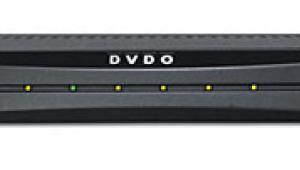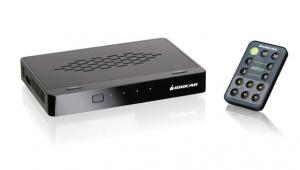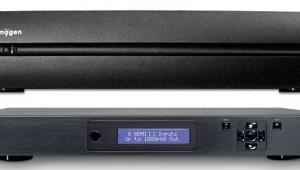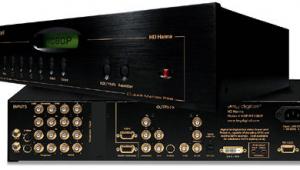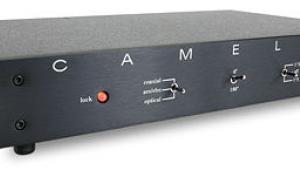3D Processor
No matter how much bigger your TV is than mine, no matter how much higher the resolution or how much brighter the image, there's one hitherto immutable aspect that both TVs have in common—the pictures on our respective TV screens are two-dimensional. They've got height. They've got width. But they ain't got depth. (Talk about flat-screen TV!) The final frontier of TV viewing is the third dimension; try as we might, watching a good 3D image on TV has always seemed about as impossible as Justin Timberlake and Christina Aguilera starring in a performance of Verdi's Aida as a fund raiser for PBS.
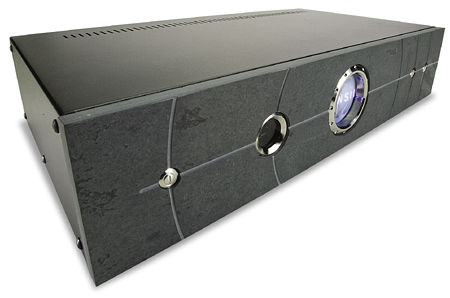
Until now, that is. Intent on overturning the two-dimensional status quo, some fanatical Canadians at a company called Sensio have put the finishing touches on a new 3D processor that could well be the most entertaining thing to happen to television since Desi met Lucy. OK, if you don't know about I Love Lucy, substitute The Simpsons, Celebrity Deathmatch, or The Jerry Springer Show as your taste dictates. The point is, Sensio's 3D processor is one definite gotta-have-it gadget. No, I didn't suffer an aneurysm in the middle of watching Spy Kids 3D, leaving me with minimal mental facilities and a cognitive grasp of only the most inane story lines. Sensio's new processor, however, has turned me into a ravenous 3D junkie.
Except for the T2: 3D "ride" at the Universal Studios theme park, most of my previous 3D video experiences have been less-than-memorable events that involved cheesy cardboard glasses with tinted lenses, cheesier story lines (with even flimsier cardboard characters), and the inevitable headache. At one time or another, you've probably experienced similar 3D novelties (either video or still images) using ultra-cheap colored glasses. This 3D technique, called anaglyph, works by creating a single image out of two color-coded images that are superimposed (slightly off kilter) on one another. The color filters effectively trick your eyes into looking in slightly different directions, giving you the sensation of depth perception, followed by the feeling that there's a jackhammer behind your sinuses after prolonged viewing.
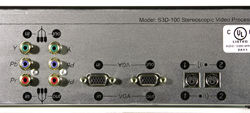 Other techniques for creating 3D video exist, however. After extensive research, the Sensio folks settled on a method that uses glasses with electronic LCD shutters that alternately open and close, allowing each eye to view the screen every other sixtieth of a second. I found the glasses to be light and comfortable, although there's certainly room for improvement. A clip-on version for people who wear eyeglasses would be nice, for example. Since the glasses shutter on and off rapidly, Sensio warns that folks who are prone to seizures should avoid wearing the glasses. They also recommend that viewers take frequent breaks while watching 3D material. That's a hard recommendation to follow, however, because the effect is highly captivating.
Other techniques for creating 3D video exist, however. After extensive research, the Sensio folks settled on a method that uses glasses with electronic LCD shutters that alternately open and close, allowing each eye to view the screen every other sixtieth of a second. I found the glasses to be light and comfortable, although there's certainly room for improvement. A clip-on version for people who wear eyeglasses would be nice, for example. Since the glasses shutter on and off rapidly, Sensio warns that folks who are prone to seizures should avoid wearing the glasses. They also recommend that viewers take frequent breaks while watching 3D material. That's a hard recommendation to follow, however, because the effect is highly captivating.
The 3D processor (model S3D-100) is a full-size (17 inches wide by 6.25 inches tall), honest-to-goodness piece of video equipment that anyone would be proud to display in their gear rack. The S3D-100's elegantly simple faceplate is covered with a slab of natural slate that has a curved grid carved into it. On the left is a small, silver power but-
ton. On the right are two matching silver buttons with up and down indicators that are used to match the sync of the processor to your TV. In the middle is a large circle with the Sensio logo that lights up when the processor is in the circuit. Between the central circle and the power button is a medium-sized circular window for the IR/IRDA receiver.
The processor's back panel is almost as simple and shows that the Sensio folks were thinking about consumers and installers during the design. In addition to an arrangement of connectors that's well spaced for an adult's hands, the input and output labels are printed both right side up and upside down. They're easily readable when you hook up the processor, whether you're behind it or bent over it. There are blessedly few connections on the back: the power cord, an input and (pass-through) output for component video, a VGA in and out, and two IR emitter jacks.
The processor comes with two pair of wireless IR glasses, a Sensio demo DVD, a feature-length Sensio-encoded DVD, and one IR emitter. The IR emitter sends a sync signal to the wireless glasses telling them when to do their thing. Because the glasses are wireless, the only limit to the number of people who can watch 3D in your home theater is the IR's spread from the emitter in the room. It's best to mount the emitter fairly high above the TV screen in the center. Sensio says the range is about 20 feet, and I'd say you can be about 40 degrees off-axis from the emitter before you lose the sync signal. (When you're out of range, the glasses stop shuttering, and the 3D effect vanishes.)
Originally designed for higher-end home theaters, the 3D processor won't work with any old TV, nor can you take any old DVD player and slap in your favorite DVD to watch in 3D. For starters, you have to use a DVD player with component video outputs (quite common on current players like my Integra DPS-8.3, as well as a borrowed Sony DVP-NS325, which both worked quite well). Since the Sensio processor requires a plain old NTSC signal, you'll need to set a progressive-scan DVD player's output to interlace. Next, you'll need a television that's capable of displaying 480p with a VGA input (analog RGB). Last, you'll need a Sensio-encoded DVD to watch.
